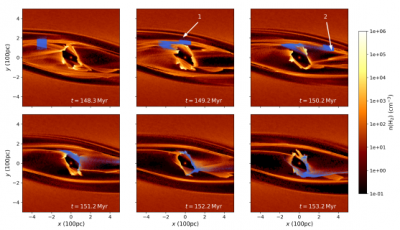H Perry Hatchfield’s stunning paper (Hatchfield et al. 2021) reporting on the current best estimate of the Galactic Center Inflow rate and the origin of molecular clouds in the Central Molecular Zone is now published in ApJ!!! Congratulations Perry!
Here is the abstract:
“The Galactic bar plays a critical role in the evolution of the Milky Way’s Central Molecular Zone (CMZ), driving gas toward the Galactic Center via gas flows known as dust lanes. To explore the interaction between the CMZ and the dust lanes, we run hydrodynamic simulations in AREPO, modeling the potential of the Milky Way’s bar in the absence of gas self-gravity and star formation physics, and we study the flows of mass using Monte Carlo tracer particles. We estimate the efficiency of the inflow via the dust lanes, finding that only about a third (30% ± 12%) of the dust lanes’ mass initially accretes onto the CMZ, while the rest overshoots and accretes later. Given observational estimates of the amount of gas within the Milky Way’s dust lanes, this suggests that the true total inflow rate onto the CMZ is 0.8 ± 0.6 M ⊙ yr-1. Clouds in this simulated CMZ have sudden peaks in their average density near the apocenter, where they undergo violent collisions with inflowing material. While these clouds tend to counter-rotate due to shear, co-rotating clouds occasionally occur due to the injection of momentum from collisions with inflowing material (~52% are strongly counter-rotating, and ~7% are strongly co-rotating of the 44 cloud sample). We investigate the formation and evolution of these clouds, finding that they are fed by many discrete inflow events, providing a consistent source of gas to CMZ clouds even as they collapse and form stars.”
Read more in the paper! Figure 5 below shows several time snapshots of the simulation demonstrating the movement of the tracer particles, how it is used to trace the inflow rate, and determine the origin of CMZ clouds.
